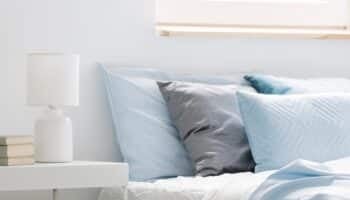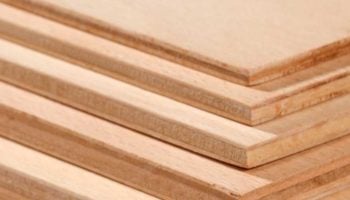We've independently reviewed this article to make sure it's as accurate as we can make it.
To find out more about our article creation and review process, check out our editorial guidelines.
Stuck trying to remove mold on plywood?
You’re not alone, I know how you feel. Dealing with black mold on plywood can be super frustrating, not only does it look bad, but in can also weaken your home’s structure.
Don’t worry, though. You’ve come to the right place to fix this issue.
To remove black mold from plywood, you’ll need to wear protective gear, identify the mold area, and mix 1 part of bleach with 3 parts of water. Then, remove the baseboards and flooring, spray the bleach solution, scrub, sand, and clean the plywood.
Read on to learn more about how to prevent and get rid of black mold on plywood!
WARNING – Black mold can be dangerous, especially to asthmatics and those with mold allergies.
We only recommend following this guide if you’re confident and well equipped with protection from mold spores. If you are dealing with a large amount of black mold, please stop here and seek professional help for safe removal.
What Causes Black Mold on Plywood?
Black mold doesn’t appear on plywood just like that. To remove it completely, it’s crucial to understand why it grows in the first place.
Moisture is black mold’s best friend, and it grows in places that are exposed to excessive moisture.

In your house, moisture typically seeps in when you have leaky pipes or experience moisture due to rain. Even if the wood dries up quickly and water doesn’t pool under the house, it still provides a growing environment for black mold.
Another cause for black mold to quickly appear and grow is the lack of ventilation.
You see, without proper ventilation, moisture can become trapped, allowing mold spores to grow.
This is why the plywood used in your basement, attic, or underneath the house is more susceptible to the growth of black mold on plywood.
Sometimes, you can even experience the unfortunate occurrence of black mold on plywood that has been just used in new construction.
This can also be caused due to the lack of ventilation, and is also possible if you live in a humid climate. Also, if the plywood used in building the structure doesn’t have a waterproof membrane or treated to be waterproof.
Now you know the causes of black mold growth in plywood construction and furniture. So let’s move on to the ways you can get rid of it and prevent it from growing again.
Is Plywood Mold Resistant?
No type of wood is strong enough to resist or prevent the growth of mold on it. Unless, of course, it’s engineered or treated to combat the growth of mold spores on it.
Normally, interior plywood has a higher moisture resistance and its planks are held together with highly resistant industrial-strength glues. This protects it from moisture and from bacteria and mold.
However, interior plywood isn’t suited for outdoor use because it’s not designed to withstand extreme weather conditions. And it’ll be difficult to stop the growth of mold if you use it for any outdoor installations or fixtures.
In this case, normal plywood isn’t mold resistant. But there’s a variant that’s called Moisture Resistant Plywood, or MR Grade Plywood, which is repurposed to keep it from soaking in moisture. And as you already know, moisture is the number one cause of mold growth.
Bear in mind that while MR grade plywood is moisture-resistant, it isn’t waterproof. This is why it is not suitable for use in areas with prolonged exposure to water, such as bathroom.
So, to answer the question, plywood will only be mold resistant until it produces or provides the conditions in which mold grows. That is moisture/dampness and lack of ventilation or an airy space.
Removing Black Mold From Plywood: 9 Easy Steps
Once you’ve noticed the presence of black mold in your home, you must get to work on eliminating it right away, otherwise it can grow to other parts of the house if it gets enough moisture and less ventilation.
Thankfully, you don’t have to throw out the piece of plywood on which you see black mold growing.
Remember, if you have asthma, are allergic to mold, do not have the correct equipment, or are dealing with a large amount of black mold, you should stop here and call a professional.
Here’s how you can remove black mold from plywood:
#1 Preparation
Start by preparing the necessary things for removing black mold.
It’s a good idea to wear old clothes you don’t mind getting stained, because you’ll be dealing with bleach.

Make sure to have safety gloves, face mask, and goggles as well. Add 1 part bleach to 3 parts water and mix it well, pouring it into a bucket. I’ll share the other things you’ll need in the following steps.
Please wear shoes that you can throw away later, or use shoe covers. Also, don’t step out of the affected area in the same footwear. That increases the chance of spreading the mold spores.
#2 Checking for Mold
If there’s black mold on your flooring or a piece of furniture, chances are it would spread to the nearby furniture, rugs, lamps, carpets, etc.
While wearing gloves and a mask, check every item for mold infestation in the room. If it has caught on to any carpet, rug, or fabric, you need to dispose of it very carefully because it can’t be treated.
#3 Cordon off the Area
Once you’ve stepped inside the affected area, make sure to seal it off and ask your family members to stay as far away from it as possible.
Grab a couple of heavy plastic sheets from the hardware store and use them to cover all entrances and exits, such as doors, windows, and vents.
Just leave one window open, and direct a fan towards it. This way the mold-affected air can be blown outside and doesn’t spread inside the house.
#4 Remove Baseboards
Even if your floor has black mold, it can very easily spread to the walls. This is why you need to remove the baseboards one by one and inspect them for mold.
If any of the baseboards is completely covered with mold, it’s best to dispose of it and get a new one.
This is because even if you treat it, it won’t have the same strength anymore. And it can also get reinfected very easily, in which case you’re back to square one.
#5 Remove Flooring
Removing the floors can take up quite a bit of your time, especially since you have to inspect all of it for mold.
If you have carpeted flooring and see mold on your carpet, you’ll also need to get rid of the entire carpet.
Starting from the edge of the room, remove the plywood boards one by one and inspect them. If they have any signs of mold, put them aside. If you have a linoleum floor, you can cut slits in the affected area and pull off the flooring.
Once you have removed the plywood flooring, take a look inside the crawl space with a torch and check if you can notice any mold there. If you see any, follow the next step to get rid of it for good.
#6 Treatment
Grab a brush or paintbrush, dip it in the bleach solution. Now use it to scrub all over the surface area of the plywood contaminated by black mold.
You may have to scrub for a while, and the results won’t be evident immediately. But make sure to cover the entire area properly.
Now wait for 30 minutes and you’ll notice the mold spores will start to die. This means that it won’t be able to spread any longer.
#7 Sanding
Bleaching the plywood will cause its grains to move to the surface. That’s why you’ll need to sand it once again, so the surface becomes smooth again.
You can use rough sandpaper and a finer grain.
#8 Clean
Grab a clean rag and dip it in a paint cleaner. Wipe it all over the plywood surface to remove any residue of black mold that’s left on it.
Leave it for another two hours to dry off. After this you can put back the piece of plywood you removed.
#9 Water-Repellent Treatment
The last step is ensuring you can prevent the growth of black mold on the piece of plywood you’re treating.
You’ll need a water-repellent preservative and apply it all over the surface. This will keep it from soaking in moisture, preventing the regrowth of black mold.
You have to leave the plywood for two days before you can paint or polish it.
Alternative Solutions
Let me share an alternative and equally effective solution. Mix 1 cup of borax in 1 gallon of water, or get an EPA-registered mold removal solution. You can spray this solution on the moldy plywood.
You can also use a mop and spread this solution across the affected plywood. Repeat this step after 10 minutes, then leave to dry.
You can then remove any dead mold or mold spores with a vacuum that has a HEPA filter. You can also rinse it with the treatment solution and disposable rags to make sure there’s no residual mold.
How to Prevent the Further Growth of Black Mold on Plywood: 3 Simple Steps
Now you know how to take care of the black mold on a particular piece of plywood. And I’m sure you hope the mold doesn’t show its ugly face ever again.
However, the reality is that you can’t guarantee this. Because after a few days, another one of the plywood planks may have the nasty growth on it.
You can’t keep removing black mold from every piece of plywood in your house. Which is why you need a permanent solution to ensure you don’t black mold in your house again.
So what’s the solution?
Luckily, there are a number of ways for preventing the growth of black mold on plywood. Let’s look at them one by one…
#1 Increasing Ventilation
As we’ve already seen, lack of ventilation inside a room, whether it’s your bedroom, basement, or attic, is a great environment for mold growth.
That’s because such spaces can easily accumulate humidity from the air as well. So make sure your vents are clean and airy.
If possible, leave the doors and windows open, too.
#2 Preventing Moisture
This is the number one method to prevent the growth of mold. Unfortunately, this is beyond your control in most cases.

However, fixing any leaky pipes, faucets, and roofs immediately can keep moisture from building up in your home.
#3 Regular Cleaning
One of the best ways to prevent mold growth in plywood is to clean your home regularly. This includes the walls, floors, furniture, fixtures, and even the crawl space, so none of these become a breeding ground for black mold.
While cleaning, you can also spray a mold-repellent solution, or use one of the mixtures I mentioned in the previous section, to ensure there are no mold spores.
Conclusion
The presence of mold in your home can be quite frustrating. And if you don’t do anything about it, you can end up with a much bigger problem.
It can weaken the plywood slabs and baseboards in your home. It can also weaken your house’s structure!
Thankfully, you can use the methods I shared in this article to not only remove black mold, but also to keep it from returning.
Liked this post? Feel free to check out other similar articles on our site.
Thank you for reading, and have a great day!
-Craig







